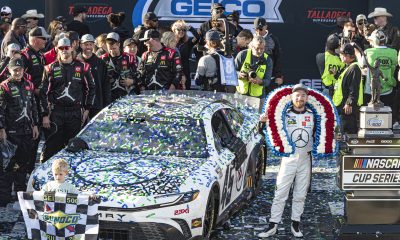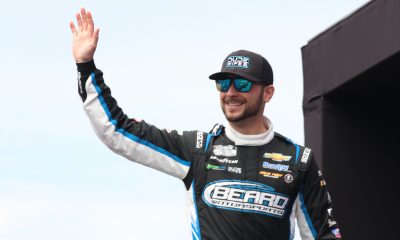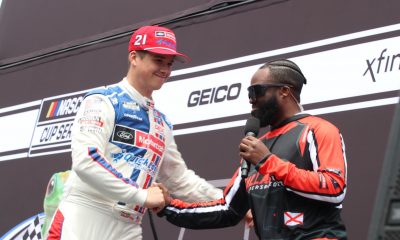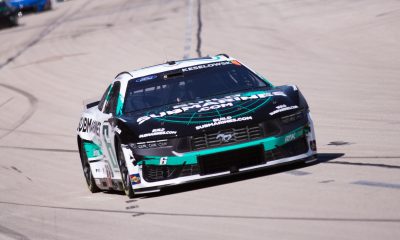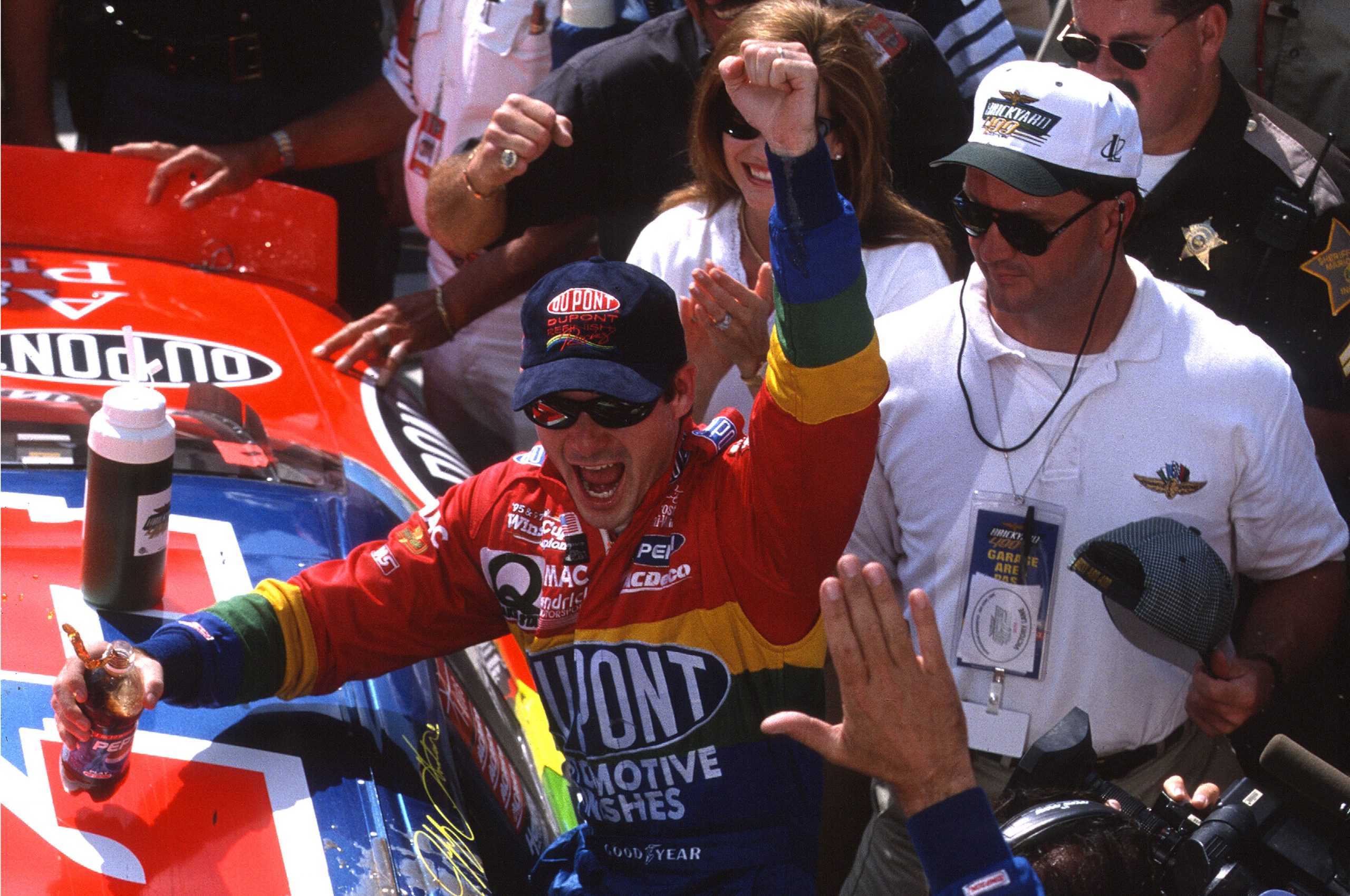
Simply put, Jeff Gordon and his No. 24 team put on a performance for the ages in 1998. (Photo: © 1998, Nigel Kinrade NKP)
DARLINGTON, S.C. — When the summer of 1998 arrived, Jeff Gordon was in pursuit of his third NASCAR Cup Series championship in his seventh season.
Fast, sleek and innovative, the crafty racer and his No. 24 Hendrick Motorsports team faced some heavy, tenacious competition in the first half of 1998. Wins at Rockingham and Bristol were offset by finishes of 16th at Daytona, 17th at Daytona, 19th at Atlanta and 31st at Texas.
Mainly, Gordon and the Chevrolet camp faced two threats in the form of the new Ford Taurus, a more aerodynamic archenemy to its beloved but aging Thunderbird. Confidence was aplenty for Dale Jarrett, Rusty Wallace, Mark Martin and Jeremy Mayfield.
The wins may have not been plentiful in the first half of 1998, but some defining turning points catalyzed one of NASCAR’s most incredible title runs. Ranked third in points despite a paltry tally of two wins going into the 1998 Coca-Cola 600 at Charlotte, Gordon seemed prime to spark another dominant run for the Cup.
A Wake Up Call for Jeff Gordon
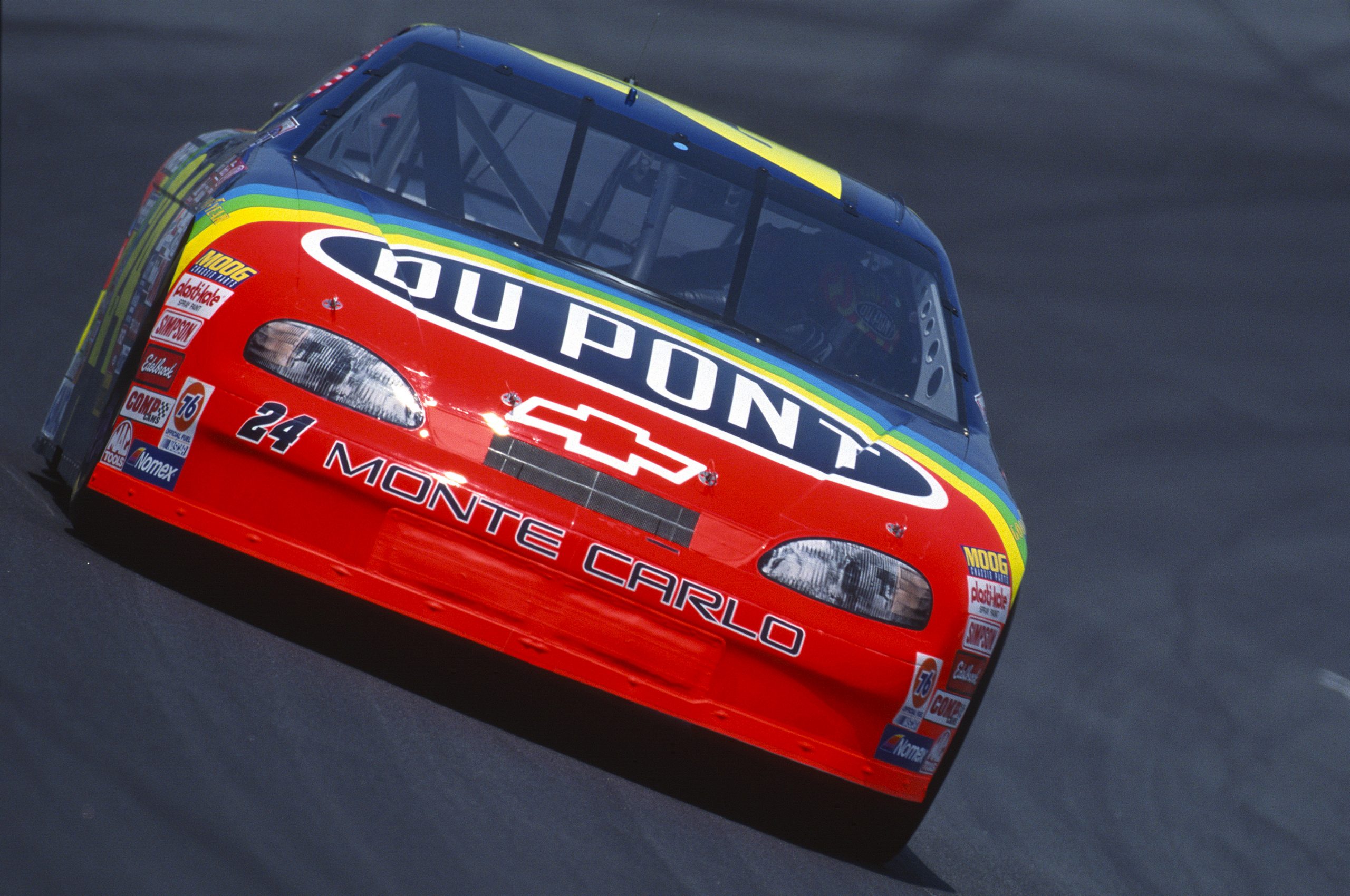
Jeff Gordon’s summer of 1998 was sparked by his Charlotte escapades and Richmond rumble. (Photo: © 1998, Nigel Kinrade NKP)
Qualifying on the pole for the Memorial Day Sunday classic, the usually unflappable driver was nowhere to be found for a Saturday morning practice session. Terry Labonte, Gordon’s teammate, took the No. 24 car for a practice run around the 1.5-mile speedway.
Typically, Labonte, “The Iceman,” is as reliable and relaxed as any driver gets in the high stakes sport of stock car racing. A cut right front tire sent Labonte into the Turn 1 wall, damaging the right front and side of Gordon’s pole winning car.
Eventually, Gordon was at the track after oversleeping, arriving to a scene of diligent crew members repairing his wounded chariot. Among those repairing his Monte Carlo was crew chief Ray Evernham, who sustained a black eye when one of the grinding wheels came apart.
Social media may have not been around, but Gordon felt as blue as any driver today who would be subjected to the criticism of fans and critics facing a similar predicament in today’s NASCAR.
Instead of wallowing too long in misery, Gordon, Evernham and his No. 24 turned a negative into a positive.
“It was a pivotal moment, kind of in the whole season, because it reenergized myself (and) my commitment,” Gordon said. “I was so disappointed in myself by missing that final practice, showing up to the track, seeing the car damaged, because they asked Terry Labonte to get in the car. He cuts a right front tire down. Luckily (he) didn’t damage it worse than he did.”
Evernham was no worse for the wear as he sported safety glasses and his driver regathered himself for the final practice session. Profusely apologizing to Evernham and his team, Gordon posted a top 10 practice speed in his repaired machine.
On the following evening, Gordon’s No. 24 was fully repaired, repainted and re-decaled. Other than a humbled driver and crew chief sporting a temporary battle scar, there was no way to know that the Saturday incident occurred.
Throughout the Coca-Cola 600, Gordon proved to be the best Chevrolet in a lead pack swarmed by Tauruses piloted by Wallace, Jarrett and Martin. Clearly, Gordon had his work cut out for him in driving the fourth best car.
Then, a Lap 379 caution for Gary Bradberry’s Turn 4 accident summoned the lead lap drivers onto pit road. Conventional thinking had the lot of the contenders opting for right side tires and fuel.
Naturally, Gordon and Evernham did not elect for the traditional tactic as the pit crew changed all four tires and refueled the No. 24 car to make the distance. Dropping to sixth place on the Lap 385 restart, it became a 16-lap dash to the finish.
From the get-go, Gordon darted to the outside of Johnny Benson Jr. to take fifth before picking off positions one-by-one to climb to second inside the 13 laps. Next on his radar was Wallace, who seemed so close to a million dollar bonus and his first Coca-Cola 600 win since 1990.
Lap after lap, Gordon drew a bead on Wallace, one of his most aggressive adversaries. Fresh tires may have played a helping hand from the onset of the Lap 385 restart but Wallace staved off Gordon with a gutsy, defensive drive.
Just three laps later, Gordon resorted to his insightful on-track presence of mind. Driving toward Turn 4 with Wallace ahead of him and a hard charging Bobby Labonte on his outside, Gordon’s car freed up just enough to barely go three wide.
Pinning Wallace and Labonte to his outside, Gordon reassumed command of the race and drove off to a 0.41 second victory.
“We come and win the race the next day,” Gordon said. “And then that was like, “Here we go.” I think what it did was it just made me realize how hard my team works and that they deserve more from me, really. I said, “I’m gonna give them everything I possibly can.” And I did and the combination was really, really strong the rest of the year.”
The Richmond Rumble
One week later, Gordon nearly won again with a dominant performance at Dover. Leading 375 laps, the Vallejo, California native had to pit for a splash and go to make the finish, handing the win to Jarrett while Jeff Burton placed second.
Settling for third, Gordon won the pole for a Saturday night showdown at Richmond. Biding his time in the 400-lap race, it looked like Gordon was going to snatch another win from Wallace inside the final 28 laps.
Suddenly, the turning point of 1998 occurred in Turn 2. Battling side-by-side for the lead, Wallace tangled with Gordon, sending him hard into the Turn 2 wall with heavy front end damage.
Typically, Gordon brushed off heated moments like this, preferring the calm and collected approach even when he was wronged.
On Saturday, June 6, 1998, Wallace officially poked the bear and woke Gordon and his No. 24 team out of kindness hibernation.
“When Rusty spun me at Richmond, I was so mad and I just wanted to make up for it in every way I possibly could, especially going head to head with Rusty from there on out,” he said with a smile. “So, I had a vendetta against him probably the rest of my career.”
Relegated to the third position in points, a path to a third championship, while attainable, seemed tougher than 1995 and 1997. Now, the competition was pushing back on the emerging racer and team.
The Summer of Jeff Gordon Begins
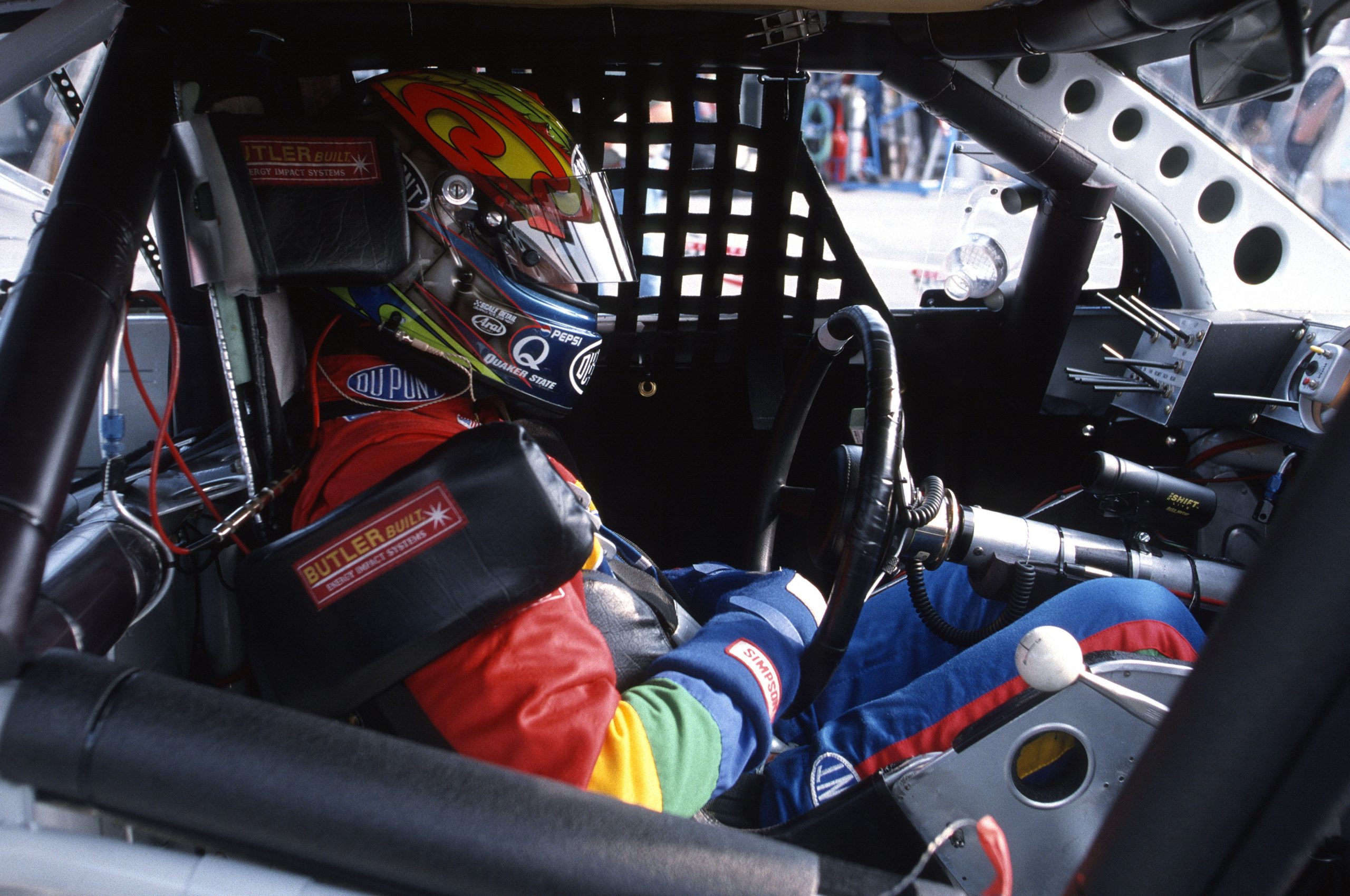
Jeff Gordon was nearly unstoppable in the summer of 1998. (Photo: © 1998, Nigel Kinrade NKP)
How would Gordon and his comrades respond to the Richmond rumble on the following Sunday at Michigan?
Their response was to the tune of a fourth place qualifying effort complimented by another strong performance, leading the field for 132 laps before placing third.
As the mercury rose, Gordon ranked second behind points leader Jeremy Mayfield. While the then 26-year-old racer racked up three wins, he had some competition from the Ford Performance camp’s Mayfield, Jarrett and Martin.
In fact, it looked like a four driver fight for the Cup especially after the running of the 1998 Pocono 500 won by Mayfield. The Owensboro, Kentucky native celebrated his maiden Cup victory considering he bested Gordon by 0.34 seconds.
Once the first Cup race of the summer of 1998 was in the books, Gordon and his No. 24 DuPont Automotive Finishes Chevrolet Monte Carlo refused to waver in the next 18 weeks. Indeed, the summer of Gordon kicked off at Sonoma Raceway with the Save Mart/Kragen 350 on June 28.
Prior to Gordon’s sixth start at the reconfigured 1.99-mile, 12-turn road course, his best result was runner-up in 1997. Despite coming up a position short of a home state victory, the foundation of NASCAR’s emerging road course warrior was established in that race.
Coming off a victory in the Bud at the Glen about 10 months in the rears, Gordon and crew chief Ray Evernham meticulously prepared for Sonoma. On this occasion, Gordon did not want to settle for second best.
Extensively testing one of their Monte Carlos with gear ratios, perfecting their transmission and executing on each corner, Gordon learned plentiful to prepare for Race No. 16 of the 33-race 1998 season.
Tallying his fourth pole of the year, Gordon had the best car at the Northern California venue. However, he had to overcome middling track position due to a plethora of pit strategies toward the halfway point of the race.
Inside the race’s 28 laps, Gordon rallied to second position, closing the gap to a matter of car lengths to leader Bobby Hamilton. Both drivers waged in an intense scrap with Hamilton relentlessly defending the lead against Gordon.
On Lap 102, Gordon got past Hamilton in Turn 12. The lead seemed a bit precarious as Hamilton kept in tow with Gordon’s car, even slamming into his right rear quarter panel and left front fender.
Although Gordon’s car had a tire rub that initially put his victory at risk, the Californian managed his car and tires masterfully, pulling away to a 2.748 second victory over Hamilton.
Little did anyone know at the time that Gordon’s Sonoma win was the start of one of the greatest championship runs in NASCAR history. Even if Ford Performance had the sleeker, more polished Taurus that challenged Gordon and his Chevrolet stablemates, the “Rainbow Warrior” racer had faith in his team and reliable fleet of Monte Carlos.
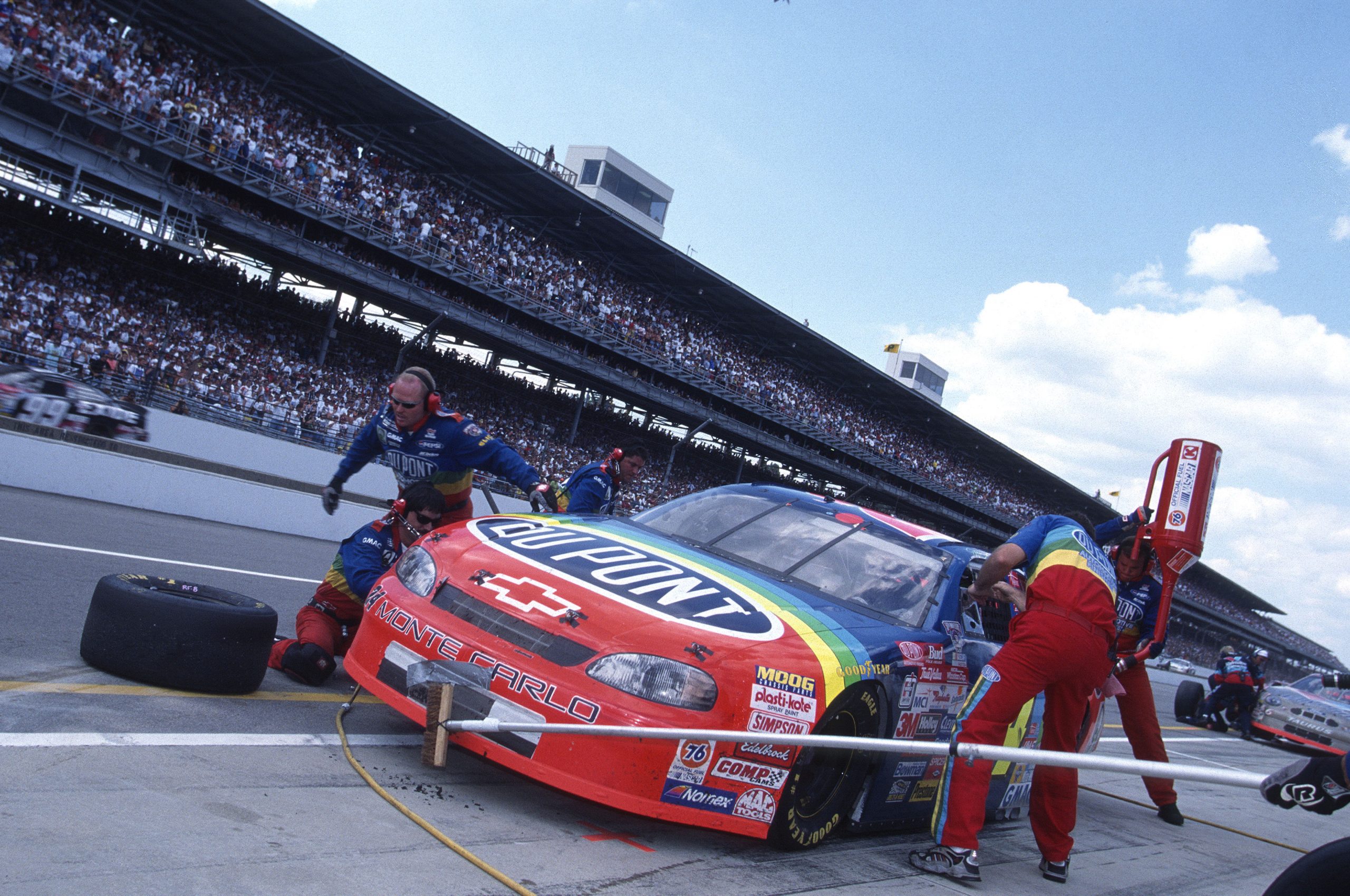
Undoubtedly, Jeff Gordon and his No. 24 team were the masters when it came to maximizing track position. (Photo: © 1998, Nigel Kinrade NKP)
“We were just so good at that time (with) just meaning in every aspect,” Gordon said. “Looking at the aerodynamics of a car, of course, the Monte Carlo is still very strong at that time. I think just the details that you still see today that Hendrick Motorsports works within to make the cars strong each and every week and on so many different types of racetracks.
“I was certainly driving with confidence. The pit crew was strong on pit road, Ray and the calls that he was making, the cars that he was bringing, the resources and just everything culminated through those mid 90s and especially in 1998.”
That summer run by Gordon and the No. 24 team still remains so remarkable and impressive 25 years later. Following his victory at Sonoma, Gordon placed third at New Hampshire after wildfires in Florida postponed the 400-miler at Daytona from Independence Day weekend to mid-October.
Afterwards, a historical run, in the making, became even more unbelievable. Arriving at Pocono Raceway for the Pennsylvania 500, Gordon qualified second before turning in a performance like Pedro Martinez for the Boston Red Sox from 1998 to 2004.
Instead of throwing strikeouts, Gordon led 164 of 200 laps, tallying one of his most dominant performances of the season. Driving to a 1.153 second win over Martin, Pocono was merely the beginning of a summertime special for NASCAR’s 50th anniversary season.
On this occasion, Gordon won four consecutive races, emerging victorious at Pocono, Indianapolis, Watkins Glen and Michigan.
“It Was Just Air, Jack!”
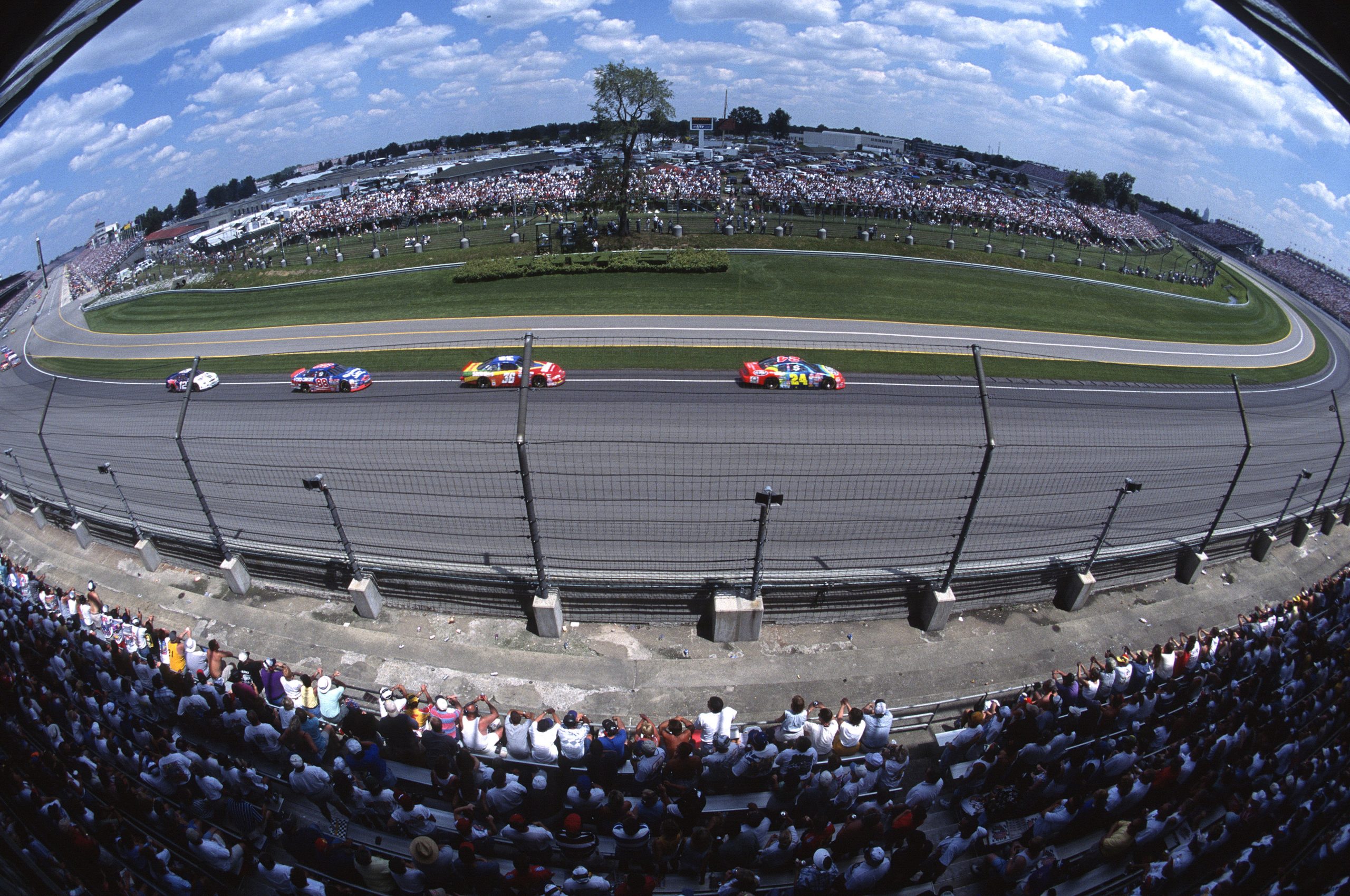
It was all about chasing the rainbow colored car of Jeff Gordon. (Photo: © 1998, Nigel Kinrade NKP)
Sure, the superstar racer and his team did their homework ahead of and during each race weekend. Nevertheless, that did not stop competitors from accusing Gordon and company of cheating.
Consider Gordon’s run to his Michigan win. In contrast to the Coca-Cola 600 at Charlotte, the field, including Gordon, changed right sides only.
Gathering up for the Lap 185 restart, Gordon found himself in third but very much in the hunt for his eighth win of 1998. Compared to the Charlotte win, Gordon’s Michigan victory seemed shocking considering how he was nearly a half lap behind the lead lap drivers in the final 20 laps.
Scoring a fifth place result at Bristol, Gordon and the Cup field returned to New Hampshire for the Farm Aid on CMT 300. Again, Gordon won the pole and it seemed like another classic setup to a Gordon win.
Only this time, it was not a straightforward path to Victory Lane. Dropping outside the top 15, Gordon had to work his way the leaderboard to eventually return to the top five.
Not long after, a Lap 256 caution for Jeff Green’s Turn 4 crash brought the field onto pit road for the final pit stop of the race. Unlike Charlotte and Michigan, Gordon’s team made a bold call, refueling the car and changing only right sides while making air pressure adjustments.
Now, Gordon found himself in the lead but with a bevy of drivers who had four fresh tires. Regardless of the odds, Gordon’s unmistakable car was too much for the competition, besting Martin to the stripe by 0.664 seconds.
Unquestionably, Gordon and his No. 24 team were making a great case to win the championship with fast cars, brave pit calls and brilliant adjustments. Again, the accusations were levied against Gordon and his crew, particularly from Jack Roush.
Evernham uttered four famous words that Gordon recalls with a chuckle and smile.
“It was just air, Jack! Just air!” Gordon said, grinning as he recalled the heated moment. “I think the No. 24 car had shown that in our very first win at Charlotte in 1994, where two tire stops and just getting track position was really, really important.
“And I think Ray put a lot of energy into trying to understand how spending less time on pit road, whether there was no tires or just two tires, even at a track where most people said you absolutely had to take four, just playing with the air pressures in order to get the balance of the car right and get off pit road faster and ahead of others.”
Advantages were found and executed fairly and wisely thanks to an attentive crew chief and over-the-wall pit crew who kept Gordon in the hunt week after week. New Hampshire was just icing on the cake.
“That’s what we did that day,” he said. “And it was a brilliant call, brilliant move. It was one that kind of set a trend for us to do more often, but really caught the attention of our competitors and made them think there’s no way that we could possibly get beat on two tires.
“They must be doing something. They must be cheating. And that’s when the famous quote from Ray of ‘It was just air.'”
The Setting Sun of Gordon’s Summer Run
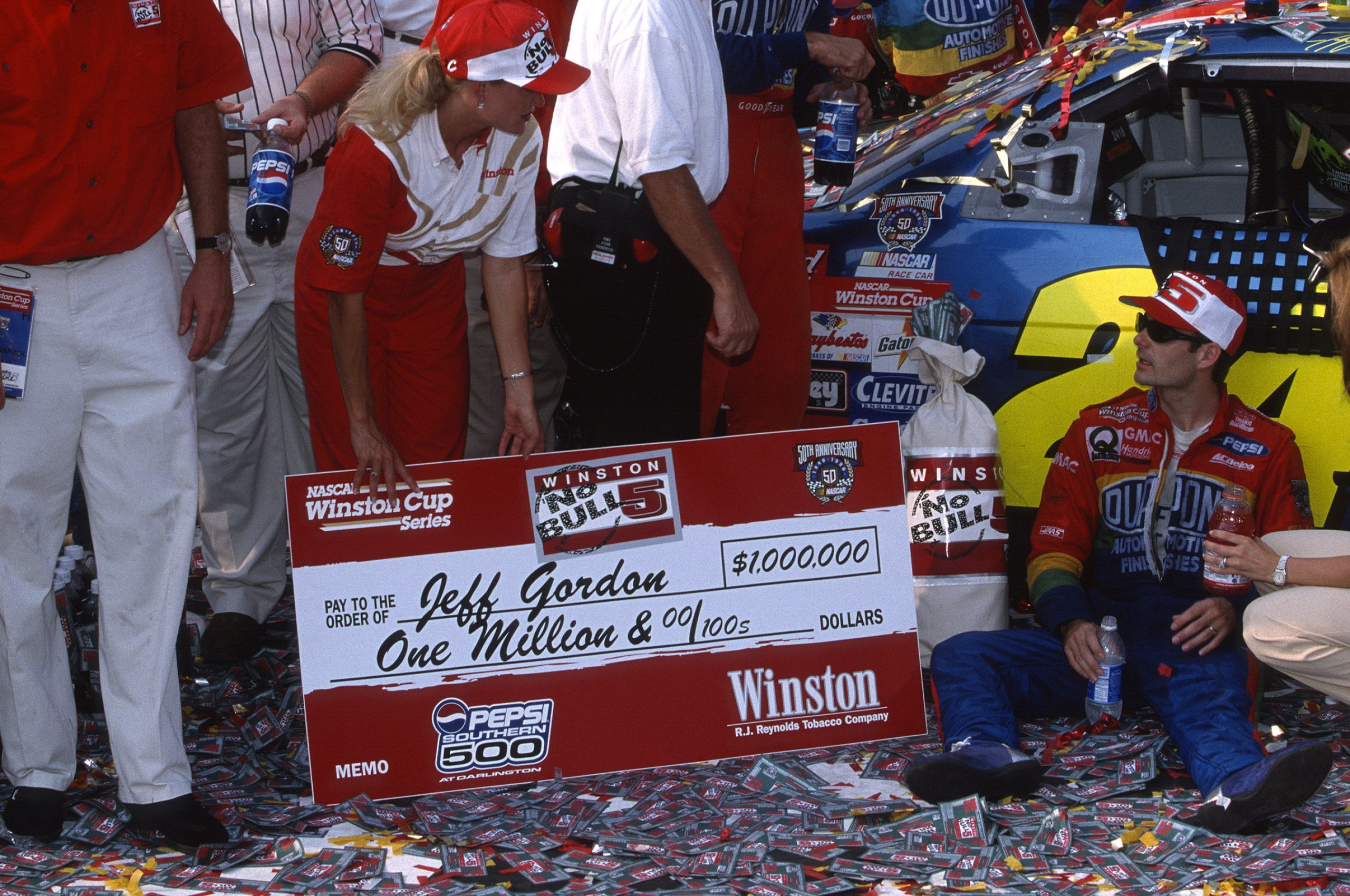
All in a hard day’s work for Jeff Gordon at Darlington. (Photo: © 1998, Nigel Kinrade NKP)
Consequently, the competition was left fuming while Gordon and Evernham were cruising to a historical summer. 10 races remained before the season wrapped up at Atlanta.
Before the summer sun traded places with the autumn win, Gordon became the $3 million man at Darlington. Winning the $1 million bonuses in the 1997 Southern 500 at Darlington and Brickyard 400 at Indianapolis, Gordon cashed in at “The Track Too Tough to Tame” for the fourth consecutive summer.
Earlier in 1998, Gordon won his fourth straight Food City 500 at Bristol Motor Speedway. Achieving a four-peat for the second time that year, the NASCAR Hall of Famer expressed fondness for his Darlington successes.
“Oh man, they’re both real standouts for me, because I love both of those tracks, but both have their own unique challenges,” he said. “I think Darlington maybe stands out more because it is such a prestigious race, the Southern 500. You know how difficult that track is to just keep a car in one piece.
“You run right next to the wall, really easy to damage the car, let alone managing the tires. It’s easy to have a lot of failures at that track because of all the grit and sand on the racetrack.”
When the summer of 1998 wrapped up at Dover’s second date, Gordon placed second to Martin. In that 12-race stretch from Pocono to Dover, Gordon won seven races and earned 12 top 10s, all resulting from top five finishes.
Most impressively, Gordon’s average finish in that span was 1.75, complimented by leading 631 of 3,229 laps or 19.54% of the possible laps in this stretch. Truly, the Summer of Gordon remains one of NASCAR’s all-time greatest performances in the series’ 75-year history.
Editor’s Notes
Excerpts from this long form feature can be found in Part I and Part II of “The Greatest Season Ever: Jeff Gordon’s 1998 NASCAR Championship” here on The Podium Finish! Thanks to Jeff, Jon Edwards and Ashly Ennis for their kindness during the EchoPark Automotive Grand Prix race weekend at Circuit of the Americas in Austin, Texas.
Rob Tiongson is a 30-something motorsports journalist who enjoys sports like baseball, basketball, football, soccer, track and field and hockey. A Boston native turned Austinite, racing was the first sport that caught his eyes. From interviews to retrospective articles, if it's about anything with an engine and four wheels, it'll be here on TPF, by him or by one of his talented columnists who have a passion for racing. Currently seeking a sports writing, public relations, or sports marketing career, particularly in motorsports. He enjoys editing and writing articles and features, as well as photography. Moreover, he enjoys time with his family and friends, traveling, cooking, working out and being a fun uncle or "funcle" to his nephew, niece and cat. Tiongson, a graduate of Southern New Hampshire University with a Bachelor of Arts in Communication, pursues his Master of Arts in Digital Journalism at St. Bonaventure University. Indeed, while Tiongson is proud to be from Massachusetts, he's an everywhere kind of man residing in Texas.

